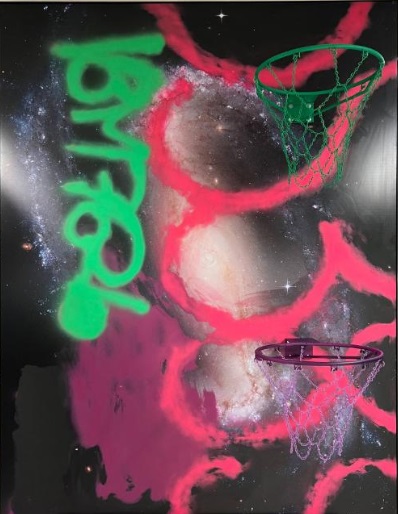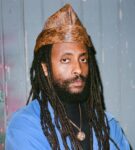
Awol Erizku
American, 1988-
No Hesi, 2022
spray paint, regulation size basketball hoops and metal chains on printed aluminum
96 × 72 × 24 in.
SBMA, Museum purchase with funds provided by Kandy Budgor; Luria/Budgor Family Foundation
2023.10

Awol Erizku Photo by David Alekhuogie, courtesy the artist and Gagosian Gallery
RESEARCH PAPER
The neon green and florescent pink spray-painted graffiti in “No Hesi” gives this artwork an urban feel. Erizku uses regulation-sized green and purple basketball hoops with metal chains hung in vertical alignment to suggest that a basketball might sink through both hoops in succession. The repeated pink semi-circular pattern is reminiscent of a bouncing basketball, evoking both rhythm and movement in its repetition. Careful examination of the black background reveals galaxies of glowing white stars layered with more graffiti and splashes of paint. Energy and excitement are created by the use of intense colors, shining stars, and basketball hoops.
Erizku often uses symbolism to create deep meaning in his artwork, and No Hesi is rich with meaning. Erizku’s works are full of references to art history, music, and spirituality. The symbolism in No Hesi is motivational in nature and speaks to the courage to make a positive investment in life. “No Hesi” invites viewers to reach for the stars, to aim high, to take the shot. The art piece is full of inspiration and tasks viewers with having goals and finding the determination not to give up when aspirations feel impossible.
The phrase “No Hesi” is an abbreviation for No Hesitation, originally used by New Yorkers to describe aggressive drivers of the congested and chaotic streets of New York City. In basketball, a Hesi refers to a hesitation dribble when an offensive player moves forward with a dribble, stops for a second to try to get the defender to set his feet, making it easier for the offensive player to get by the defender.
The title, “No Hesi,” fits the contemporary nature of the artwork, evoking hip hop music, urban vocabulary, and youth. This artwork speaks to everyone, especially young people, who need to find the courage to dare to dream, to work hard, to take risks, and to believe they can accomplish great things.
Los Angeles based multidisciplinary artist Awol Erizku was born in Ethiopia in 1988, but grew up in the South Bronx, New York, in the inner city. He graduated from the Cooper Union with a Bachelor of Fine Arts degree and then received his Master of Fine Arts from Yale.
“No Hesi” also acknowledges African American urban life, aspirations, and striving. In fact, basketball hoops typically have nylon nets in professional basketball. However, the hoops in Erizku’s work have metal chain hoops that are often found in public courts such as in parks or urban cities. These hoops are reminiscent of the hoops where Erizku played during his life growing up in the Bronx.
Awol Erizku is known for his photography, painting, sculpting, and sculptural installation work. The Santa Barbara Museum of Art has three of his pieces in the collection that are currently on display: “Nefertiti: Miles Davis” (2022), Untitled (Amanda) 2021, and “No Hesi” 2022. Erizku explains that “No Hesi” from his Cosmic Drill series, relates to Drill, a genre of hip hop that originated in Chicago in the early 2010s. Drill music typically reflects life on the streets and is gritty, realistic, and sometimes graphic. Erizku is a musician and a DJ who often prepares custom mixed tapes to pair with his shows, so music is an important part of his art.
With the aim of drawing attention to the lack of racial diversity through the history of painting, Awol Erizku creates art that evokes classical paintings whose subjects are replaced with models of color. Through the wide range of mediums, he represents unjustly neglected African figures. Erizku’s art seeks to bridge the gap between African and African American visual culture. Erizku rejects Eurocentric notions of art and beauty in favor of building a singular Afrocentric aesthetic that he calls “Afro-esotericism.”
Erizku may be best known for his photograph of the pregnant Beyonce’s announcement that she was having twins in 2017. It was the most liked post in Instagram history with a record ten million likes. Erizku has also taken many other memorable photographs of such notable people as Michael B Jordan for “GQ” and the inauguration poet Amanda Gorman for the cover of “Time Magazine.”
Although he has been recognized for his photographs, Erizku considers himself an artist first, and wants to be remembered for his art that is not constrained by boundaries of reality or of the current conditions in the world. Erizku seeks to build his own Afrocentric perspective which acts as a counternarrative to the historically westernized discourse on African and African American culture.
Prepared for the Santa Barbara Museum of Art Docent Council by Debbie Auday, 2024
BIBLIOGRAPHY
Allen, Tyus. “Awol Erizku: Cultural Identity.” Global Contemporary Artist Analysis Archive Project, 2022
https://scholar.utc.edu/cgi/viewcontent.cgi?article=1005&context=global-contemporary-artists
Bailey, Stephanie. “Awol Erizku’s Global Afropolitism.” OCULA, March 9, 2022
https://ocula.com/magazine/insights/awol-erizku/
Ben Brown Fine Arts. “Awol Erizku: Cosmic Drill.” January 27, 2023
https://www.benbrownfinearts.com/exhibitions/191-awol-erizku-cosmic-drill/
Community Contributor, “Beyond Conversation at the Santa Barbara Museum of Art Presents Radiant Frequencies.” January 1, 2023
https://www.sbma.net/events/beyondconversation
Cue, Elena. “Awol Erizku: Beauty is a Universal Language.” HuffPost, May 24, 2017
https://www.huffpost.com/entry/awol-erizku-beauty-is-a-universal-language_b_59258bc8e4b09c5b6bf92d6c
Duron, Maximiliano. “At Gagosian, Awol Erizku Takes Apart the Sphinx to Offer New Possibilities for Imagination.” ARTNEWS, March 11, 2022
Monsoor, Sanya. “Awol Erizku: The Story Behind Time’s Amanda Gorman Cover.” Time, February 4, 2021.
https://www.benbrownfinearts.com
Pogrebin, Robin. “Beyond Beyonce Fame, Awol Erizku Expands What Black Art Can Be.” New York Times, March 8 and 10, 2022. https://www.nytimes.com
Thomason, Isobel. “Awol Erizku, Beyoncé’s Instagram Portrait Artist, Will Hate This Headline About His Trump-Inspired London Show.” Vanity Fair, April 21, 2017.
https://www.vanityfair.com
